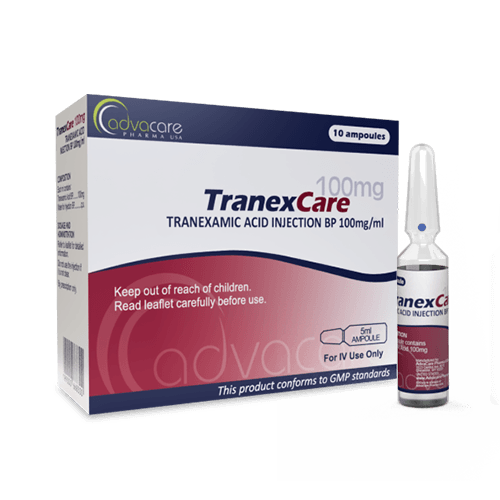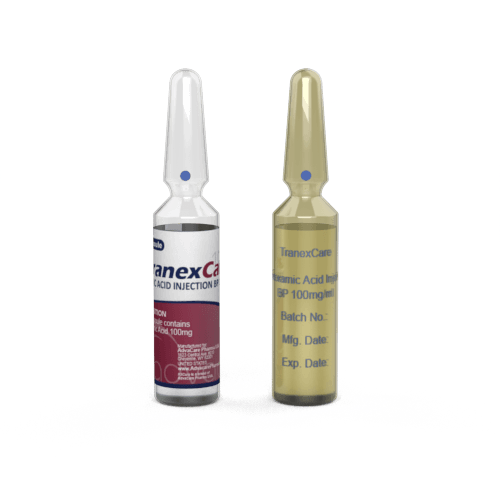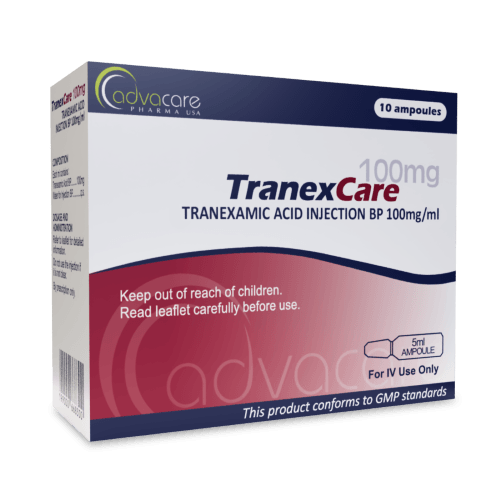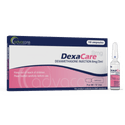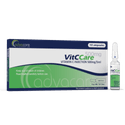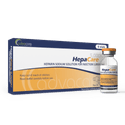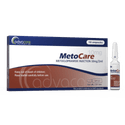- Home›
- Pharmaceuticals›
- Injections›
- Small Volume Injections›
- Tranexamic Acid Injection
Tranexamic Acid Injection
Dosage
Packaging
What is Tranexamic Acid?
Active Ingredients: Tranexamic Acid
Tranexamic Acid Injection is used for the short-term control and prevention of excessive or heavy bleeding during certain dental procedures in patients with hemophilia. This drug may also be used to reduce bleeding and the need for blood replacement therapy associated with trauma or orthopedic surgery.
Tranexamic acid is classified in the family of medicines called antifibrinolytics. It is a synthetic derivative of the amino acid lysine. It works by stopping blood clots from breaking down.
Tranexamic Acid Injection is available in two formulations, 250mg/5ml and 500mg/5ml. The solution is packaged in ampoules, which are available in packs of 10 or 100.
This medication is produced and exported by AdvaCare Pharma. Tranexamic Acid Injections are manufactured in our facilities in China, India, and the USA. Our factories comply with WHO guidelines and standards, and we regularly inspect these facilities to ensure they meet these high standards.
Why are we a leading Tranexamic Acid manufacturer?
AdvaCare Pharma, a US-owned pharmaceutical company, is a manufacturer of Tranexamic Acid with GMP-compliant manufacturing facilities located worldwide. We conduct frequent GMP, third-party and internal facility inspections to ensure that our manufactured injectable treatments exceed the stringent requirements of importing countries and our distributors.
As a renown Tranexamic Acid manufacturer and global supplier of 120+ pharmaceutical injection products, our global reach extends to over 65 markets ensuring that pharmaceutical distributors, hospitals, pharmacies, NGOs and government institutions receive the quality-assured treatments they need.
Uses
What is Tranexamic Acid used for?
It is used to control bleeding caused by dental procedures for patients with hemophilia. It is also used to reduce bleeding associated with trauma or orthopedic surgery.
Tranexamic acid is also used (off-label) in severely bleeding patients requiring massive transfusion protocols (MTP) or when hyper-fibrinolysis is demonstrated and in dermatology for the improvement of melasma and as a maintenance treatment of hereditary angioedema and urticaria.
How are Tranexamic Acid Injections used?
This medication is manufactured as a solution to be injected into a vein. It is to be administered by a healthcare professional in the hospital or clinic setting.
Before administration, the solution should be carefully inspected for any visual particles or discoloration.
Diluted mixtures of tranexamic acid can be kept for up to 4 hours at room temperature.
After use, any unused portion of the medicine should be discarded.
How should Tranexamic Acid Injections be stored?
Any unused ampoules of tranexamic acid should be stored in a dark location below 25°C. Do not freeze this medicine.
What dose should be given?
Adult Dosing Dosage may vary based on different medical indications:
- For dental bleeding prophylaxis in patients with hemophilia, the usual dose is 10mg/kg IV right after the procedure and then 10mg/kg IV, given 3-4 daily for 2-8 days. Tranexamic acid should be used with factor replacement treatment.
- For postpartum hemorrhage, the usual dose is 1000mg given IV within 3 hours of delivery. The dose may be repeated once.
- For hemorrhage associated with trauma, the usual dose is 1000mg given IV within 3 hours of injury, followed by 1000mg given IV over 8 hours.
- For bleeding prophylaxis during hip replacement surgery, the usual dose is 1000mg given IV prior to incision, followed by 1000mg given perioperatively and/or postoperatively. Alternatively, 10-15mg/kg per dose can be given once IV, followed by 1mg/kg per hour by IV infusion for 10 hours.
- For bleeding prophylaxis during knee replacement surgery, the usual dose is 1000mg given IV prior to incision, followed by 1000mg given perioperatively and/or postoperatively. Alternatively, 10-15mg/kg per dose can be given once IV, followed by 1mg/kg per hour by IV infusion for 6 hours.
- For bleeding prophylaxis during cardiac surgery, the usual dose is 50mg/kg per dose given once IV 30 minutes after anesthesia induction, followed by 16mg/kg per hour IV until sternal closure. Adding a prime dose to the cardiopulmonary bypass circuit can be considered.
Renal Dosing Renal dosing for dental bleeding prophylaxis should be based on serum creatinine levels. Dosing recommendations are as follows:
- Cr 1.36-2.83mg/dL (120-250micromol/L): 10mg/kg per dose, given twice a day
- Cr 2.83-5.66mg/dL (250-500micromol/L): 10mg/kg per dose, given once per day
- Cr >5.66mg/dL (>500micromol/L): 10mg/kg per dose, given every 48 hours or 5mg/kg per dose given once a day
Pediatric Dosing Recommended dosage for children may vary based on different medical conditions:
- For dental bleeding prophylaxis in patients with hemophilia, the usual dose is 10mg/kg per dose, given right after the procedure, and then 10mg/kg IV, given 3-4 daily for 2-8 days. Tranexamic acid should be used with factor replacement treatment.
- For bleeding prophylaxis during cardiac surgery in pediatric patients over 2 months old, the usual dose is 1-10mg/kg per hour. The starting dose should be 10-100mg/kg per dose, given IV after anesthesia induction. The maximum dose is 2000mg per dose.
- For children with renal impairment, the adult renal dosing guidelines should be considered for guidance.
Refer to a doctor or pharmacist for guidelines on dosage. The exact dosage is based on medical condition, response to the treatment, age, and weight.
Who can use Tranexamic Acid?
Tranexamic Acid Injection can be administered to adults and children, but caution is advised for specific groups of patients.
Pregnant Tranexamic acid should only be administered to pregnant women if the benefits outweigh the risks. Human data has shown that tranexamic acid is transmitted through the placenta. There is a possible risk of fetal and/or neonatal functional issues, including neonatal sepsis and cephalohematoma. Low birth weight and pre-term birth have also been reported in additional clinical studies.
Breastfeeding Tranexamic acid should only be administered if the benefits outweigh the risks. Published reports indicate that tranexamic acid is excreted into human milk. There is no known risk of infant harm based on limited human data, and there is not sufficient human data to assess the effects on milk production.
Children No significant pharmacokinetic differences have been reported for pediatric patients when compared with adults, though the benefits should be weighed against the risks when treating children under 2 years old. It is recommended to reduce the dose for children under 2 years old who also have mild or moderate renal impairment. This drug is not recommended for children with severe renal impairment.
Geriatric Human data does not suggest pharmacokinetic differences in elderly versus younger patients. It should be noted that tranexamic acid is largely excreted by the kidneys. As older patients are more likely to have renal insufficiency, it is advised to express caution when selecting the appropriate dose. In addition, some clinicians may find it useful to monitor renal function during treatment.
Other warnings
Caution should be expressed when treating patients during cardiovascular surgery or those with DIC, upper urinary tract bleeding, a history of thromboembolism, or a history of seizures.
For patients with renal impairment, it is recommended to follow the renal dosing guidelines, as lower doses are necessary, as blood levels of the drug are increased in this population.
Dose reductions are not necessary for patients with hepatic impairment, as tranexamic acid is excreted unchanged.
There is an increased risk of venous or arterial thrombosis associated with tranexamic acid. Avoid concomitant use with factor IX, as there is an increased risk of thrombosis. In addition, patients taking hormonal contraception should be advised to use non-hormonal options during therapy.
This medication is intended for intravenous use only. It should be noted that accidental injection into the neuraxial system may cause seizures or cardiac arrhythmias.
Side Effects
As with all pharmaceuticals, some unwanted effects can occur from the use of Tranexamic Acid Injection.
Common side effects include, but may not be limited to:
- headache
- joint or muscle pain
- spasms
- cramps
- nasal or sinus congestion
- stomach pain
- tiredness
Serious side effects may include:
- signs of an allergic reaction
- changes in vision
- seizures
- problems with urination
- signs of a blood clot in the lungs or legs
- signs of a stroke
For a comprehensive understanding of all potential side effects, consult a medical professional.
If any symptoms persist or worsen, or you notice any other symptoms, please call your doctor.
Precautions
Do NOT use Tranexamic Acid Injection if:
- You are hypersensitive or allergic to tranexamic acid, or any ingredient in the solution
- You have blood clots, a history of blood clots, or conditions that may increase the risk of blood clots.
- You have bleeding in the brain, blood in the urine, or bleeding related to kidney problems.
- You are color blind or have problems with the optical blood vessels.
- You have irregular menstrual bleeding of unknown cause.
- You are using birth control that contains estrogen or progestin.
- You are using medicine to help your blood clot.
Before treatment, consult your doctor regarding any medications you are taking to address potential drug interactions.
This medication may not be suitable for people with certain conditions, so it is important to consult with a doctor if you have any health conditions. Some conditions that may need additional consideration include kidney disease, bladder/kidney infection, or leukemia.
Driving and operating machinery should be avoided during treatment with tranexamic acid, as it is known to cause dizziness as a side effect.
Tranexamic acid can be mixed with most solutions intended for infusion, including electrolytes, carbohydrates, amino acids, and Dextran. Heparin can be added to this medication. It should be noted that tranexamic acid is not compatible with blood or penicillin antibiotics.
References
Tranexamic acid combined with recombinant factor VIII increases clot resistance to accelerated fibrinolysis in severe hemophilia A
This study evaluates whether the clot stability in hemophiliacs could be improved by treatment with tranexamic acid (TXA) in combination with recombinant factor VIII (rFVIII).
Baseline blood samples were taken from eight males with severe hemophilia A. A bolus injection of rFVIII was administered to elevate the functional level of FVIII to approximately 50%. After a 10-minute interval, blood was collected, followed by an intravenous injection of TXA. Another blood sample was obtained after an additional 10 minutes. Thrombelastography using minimal tissue factor activation was utilized to determine whole blood clotting profiles, assessing both clot initiation and propagation. Clot stability was evaluated at clot termination using parameters such as maximum clot firmness and area under the elasticity curve.
The results showed that rFVIII enhanced clot formation, while TXA did not affect this parameter. Assessments involving tissue-plasminogen activator demonstrated that rFVIII tripled the maximum clot firmness, whereas the presence of TXA resulted in an additional quadrupling of this increase.
The conclusion is that simultaneous treatment with TXA and rFVIII significantly improves clot stability in patients with hemophilia A.

You might be interested in...
Why AdvaCare Pharma?
As an industry leader, we are aware of our responsibility to provide affordable and sustainable solutions to improve healthcare worldwide.
